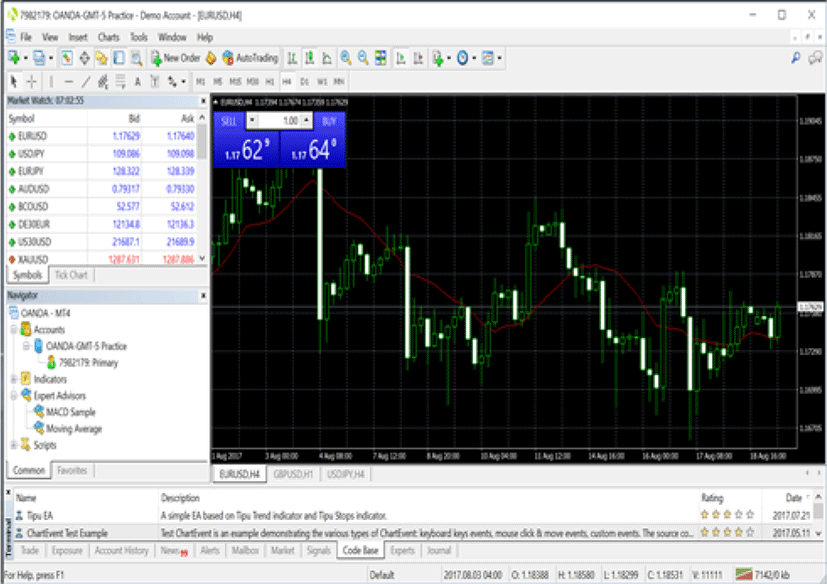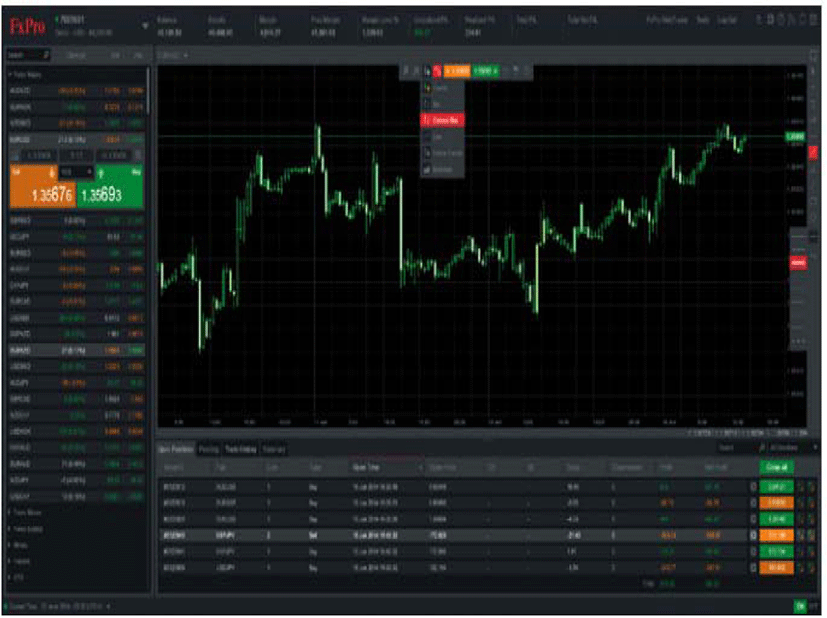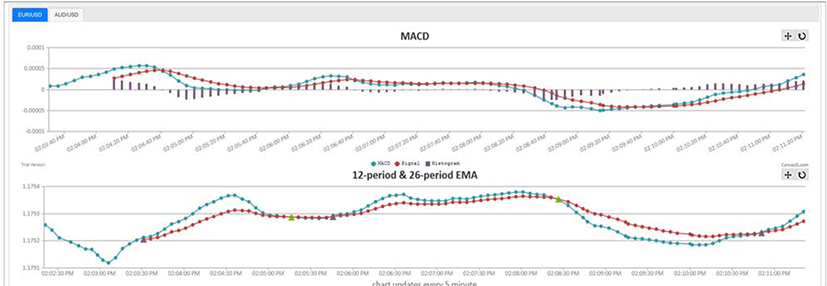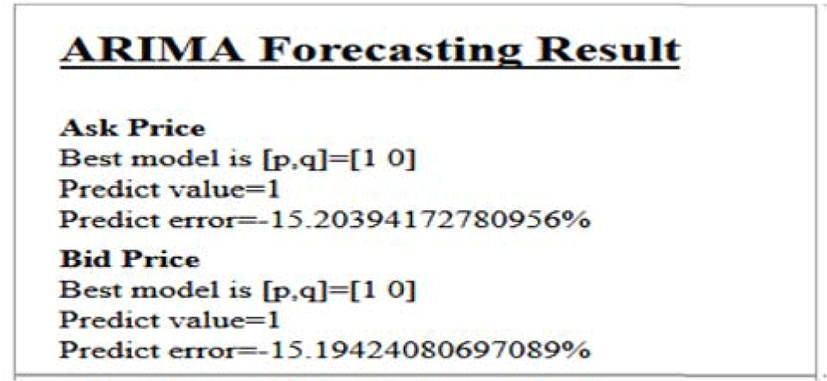I. INTRODUCTION
The foreign exchange (FOREX) market exist within a relatively complex and volatile financial ecosystem. With traders often aiming to obtain a substantial amount of profit when trading, a thorough analysis of the currency exchange fluctuation is required to navigate the market [1].
Hence, an integral component of trading involves monitoring the FOREX price fluctuation throughout the day. Recent advancement in technology have been embraced to develop automated trading platforms that will be useful to the traders. Not only does the automated trading platform provide ease of access to the traders, it also enables the integration of cross – disciplinary analysis methods originating from both the computer science as well as finance discipline to effectively analyse and forecast future currency exchange price. However, the potential of the trading system has not been utilised to its full potential. Oftentimes, traders must resort to using additional resources to obtain knowledge on the various analysis and forecasting methods. Although traders have the option of using the demo accounts for practice purposes, it is only natural that enhancements could be made to by integrating e – learning elements into the trading platform which has not been fully implemented in any of the trading platforms surveyed. This is important to disperse more knowledge and information to the traders that will help them gain a better understanding the market and aid in the decision-making process when trading
II. FOREX TRADING OVERVIEW
The FOREX market is constantly affected by various external factors such as political stability, economic events, terms of trade, economic performance, trader’s psychology, natural disaster, etc. The challenges presented due to the inherent intricacies of the FOREX market have made it one of the hottest topic within the research and trading community. Thus, it is not surprising that traders often rely on a wide range of information resources and analysis methods for FOREX price forecasting. In general, the analysis methods available can be categorised into two major categories: fundamental analysis and technical analysis.
Fundamental analysis focuses on explaining the fluctuation of currency exchange price from the angle of cause and effect using macroeconomic data. For that reason, current information is normally acquired from various newspaper article/online source [2], text mining [3] – [4] as well as twitter sentiments [5]. On the other hand, technical analysis operates on the assumption that historical FOREX data reveals repeating patterns over time when analysed thoroughly [6] – [8]. However, it has been observed that technical analysis methods are preferred by traders for reason that will be discussed further in Subsection 2.1 below.
Technical analysis methods have always been the preferred analysis method chosen by traders in the industry as demonstrated by the survey conducted in various studies whereby 90% of respondents prefer to use technical analysis [8], [9]. In addition, between 30% and 40% of professionals consider technical analysis as their most important trading technique [8] with researchers such as Hsu et al. [10] obtaining encouraging results from the analysis conducted. As the method primarily focuses on the use of FOREX historical data, it works to address some of the shortcomings experienced by analysts using fundamental analysis, viz. the lack of economic data in high frequency and the poor performance of fundamental models for short-term exchange rate forecast [11]. In fact, Neely and Weller [7] quotes a study by Taylor and Allen conducted in the year 1992 whereby traders utilise technical analysis much more frequently than they do the fundamental analysis for short-term analysis (less than a week).
Technical analysis encompasses various analysis methods that can be further divided into two main categories, viz. mechanical and charting based analysis. Mechanical analysis relies upon the use of a statistical-based model for forecasting whereas charting based analysis relies upon the detection of predefined patterns from the historical data. Charting based analysis is thought to be unreliable and extremely subjective as it is heavily dependent on the prior experience and heuristics of the trader performing the analysis.
With computational finance gaining interest and momentum in the financial world, soft computing techniques have been increasingly used for FOREX forecasting. Researchers such as Gerlein et al. have explored the use of simple machine learning methods for financial trading [12]. In addition, methods involving Artificial Neural Network (ANN) [13] – [15], Genetic Algorithm (GA) and its various derivatives [16] - [18] Neuro-Fuzzy Computing [6], [19], as well as Support Vector Regression (SVR) [9], [20] – [22] have also been utilised for analysis and forecasting with promising outcome. From the analysis and forecasting results, various trading indicators and rules are subsequently applied to generate buy/sell recommendation to the traders.
III. FOREX TRADING PLATFORMS
Regardless of the FOREX analysis and forecasting method applied, trading platform remains a crucial tool for FOREX trading. This is partly because trading platform not only offers a plethora of tools from analysis, visualisation, and trading options, all the elements combine to offer traders a cohesive outlook on the market along with trading recommendations (buy/sell) if supported by the platform. The tools offered provide an advantage to the traders as it offers numerous important information to consider with the final aim of performing profitable automated trading. Gallo [23] provides an extensive discussion of how computational tools can help with financial forecasting as well as various trading rules practiced by the traders.
With personal computing devices such as computers and smartphones becoming easily accessible, both software-based as well as web-based trading platforms have been developed. Albeit providing the same functionalities, subtle differences between both the software-based and web-based platform in terms of usability and feasibility affects the trader’s choice. Therefore, the pros and cons of each of the trading platforms are as summarised in Table 1. Keeping that in mind, a thorough look at the various trading platforms available in the market and its functionalities would give a better understanding on each of the implementations.
As previously discussed, the FOREX trading platform have grown to offer more than just mundane monitoring task and buy/sell transactions. Since additional features are added progressively, FOREX trading platforms must be flexible enough to allow for easy integration of new features and personalisation capabilities to cater to the traders. Software-based platforms such as OANDA MetaTrader [24] shown in Figure 1 below offers more flexibilities and functionalities whereby the platform capability and features could easily be expanded by developers proficient in the programming language as listed in Table 2. In fact, researchers such as Pinto and Silva [25] have also implemented their proposed system using Meta Trader (version 5) with MQL5 programming language.
| Trading Platform | Programming Language |
|---|---|
| CQG [28] | C#, C ++, Visual Basic, Python and Matlab via API |
| Ensign Windows [29] | ESPL(similar to Delphi) |
| MetaStock [30] | MetaStock Script Language (simple, outdated) |
| MetaTrader (MT) [31] | MetaQuotes Language MQL4 / MQL5 (C based) |
| MultiCharts [32] | Easy Language and C# (new .NET version) |
| NeoTicker [33] | Delphi & Neoticker formula language |
| NinjaTrader [34] | C# & NinjaScript (extension of C#) |
| SierraChart [35] | C++ & ACSIL (extension of C++) |
| Tradecision [36] | Improvian (simple language) |
| TradeStation [37] | Easy Language |
| Wealth-Lab [38] | C# + Wealth-Script |
Although the web-based trading platform is not totally devoid of additional features, it is not easily adaptable and customisable. However, it is more practical and easily accessible as it only requires web browser access from a computer or mobile browser when accessed via smartphone/tablet. Among the well-known web based trading platform are IQ Option [26] and FxPro MT4 (MetaTrader 4) WebTrader [27]. The online interface for the FxPro MT4 WebTrader trading platform is as shown in Figure 2. Satisfying most of the basic requirement often required by traders, it is deemed to be adequate for novice and intermediate level traders.
In general, the functionalities provided by the platform can be classified into five main groups, namely data selection, technical analysis, expert system implementation, display, and trading support. Data selection not only allows for selection of various currency pair but also the time interval between each data point. Technical analysis often pertains to the calculation of the various technical indicators implemented by traders. Apart from adding it to the display area alongside the real-time data to observe its effects, the technical indicators are also subsequently incorporated into various trading rules that will determine the buy/sell status. Depending on the platform, expert systems available could also be invoked to provide a trading recommendation. Lastly, trading support is also incorporated into the trading platform whereby certain stop loss or limit order rules are implemented within the platform. Figure 3 below shows an example of the FxPro MT4 WebTrader implementation of the functionalities examined.
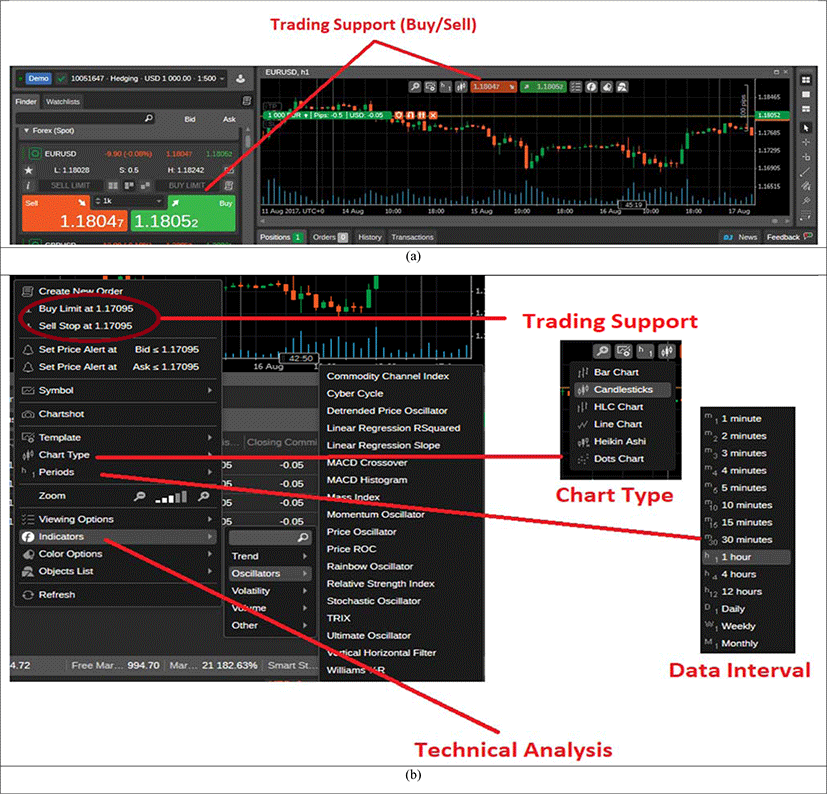
IV. PROPOSED E-LEARNING TRADING PLATFORMS
This paper proposes the development of a web-based binary trading platform which does not only allow for traders to perform basic FOREX transaction but also acts as an e-learning tool for novice/beginners. While most of the features within the proposed implementation are available in most of the trading platform, the novelty lies within the trading recommendation system. In addition, elements of e-learning are also incorporated whereby the concept behind each technical indicator and machine learning algorithm implemented would be explained within the system. The information provided would be invaluable especially for novice traders just learning to navigate the FOREX market.
The proposed e-learning trading platform developed using JavaServer Pages (JSP) technology alongside server connection provided by the OANDA API consist of all five of the main functionalities as discussed in Section 3.2. The OANDA API is instrumental in obtaining real-time currency exchange data for the proposed trading platform. With the successful acquisition of the real-time currency exchange data from the OANDA server, the information will be updated to the web page display according to the pre-determined time interval.
As the proposed system is still at a preliminary stage, two different technical indicators are chosen for implementation. Albeit being two of the most basic technical indicators used, the Moving Average Convergence Divergence (MACD) and the Exponential Moving Average (EMA) technical indicator proves to be extremely useful as various trading rules are often formed with the additional information. Pertinent information such as a short description of the technical indicator as well as how it is obtained are also shown to the traders. Additional technical indicators will be provided to the as development work progresses to give traders more options.
The calculation for EMA is as stated below in equation (1) and (2) whereby Pq denotes the current exchange price, q is the qth data of the exchange price and EMAq is the EMA value of the qth price index. α refers to the decay factor which can be calculated as: 2/(m+1) whereby m is the time window defined.
Once the EMA is obtained, the MACD can be easily calculated as it is dependent upon the EMA results as shown in equation (3) – (5).
Albeit having similarities with the existing trading platform up to a certain degree, the subtle differences of the proposed trading platform as illustrated in Figure 4 – Figure 8 will be highlighted. Firstly, the display of technical indicators with a customisable time interval are maintained like the existing trading platforms such as shown in Figure 4. However, additional information and explanation pertinent to the e-learning module would be situated underneath the main display. If the amount of data on display gets too over-crowded, the zoom and pan feature implemented would come in handy as it enables the trader to select the area to zoom by clicking and dragging over the area rather than the conventional implementation which offers more control as depicted in Figure 5. Traders could also opt to use the traditional zoom and pan feature by clicking on the button situated at the top right of the display. Lastly, traders are also given the option to hide certain plots on the display by clicking on the wording of the display legend and the plot will be hidden as shown in Figure 6 and Figure 7.
As for the forecasting module, the forecasting result using machine learning analysis methods will also be provided to the traders such as shown in Figure 8. The degree of complexity on the forecasting result provided to the traders can be personalised as the level of details displayed is entirely up to the traders. The display could range from a simple buy/sell recommendation to detailed forecasting result obtained from the machine learning algorithm. The information provided will inevitably be different depending on the machine learning method chosen by the traders.
The implementation of trading rules on the proposed trading platform is also made possible as it is based upon the use of simple existing technical indicators such as EMA. A simple example of a trading rule implemented is as shown previously in Figure 4 whereby the recommended buy/sell decision based on the EMA crossovers is incorporated into the charts as denoted by the triangle plot at the crossover points of the 12-period and 26-period EMA. Together with the forecasting result provided by the machine learning algorithm, traders are able to take into consideration all the information provided when making the final trading decision.
V. CONCLUSION
In conclusion, a novel web-based trading platform integrated with e-learning features for FOREX trading is proposed. With extensive study of the FOREX trading on various aspects such as analysis, forecasting, and various trading rules carried out, it is important that traders can implement it without hassle in their everyday trading. The proposed system not only allows for ease of implementation but enables the disseminated of knowledge to all traders in hopes that it will lead to profitable investments.
Among some of the future work on the proposed trading platform with regards to the e – learning module involves the addition of more technical indicators and machine learning module for forecasting. Apart from that, the forecasting result display along with the minute details returned by the forecasting module implemented will also be further improved to enable customisation by the trader. Apart from that, the support for stop loss or limit order rules when trading would also be a useful addition into the trading platform to ensure that it achieves its fullest potential with a variety of tools for traders.








